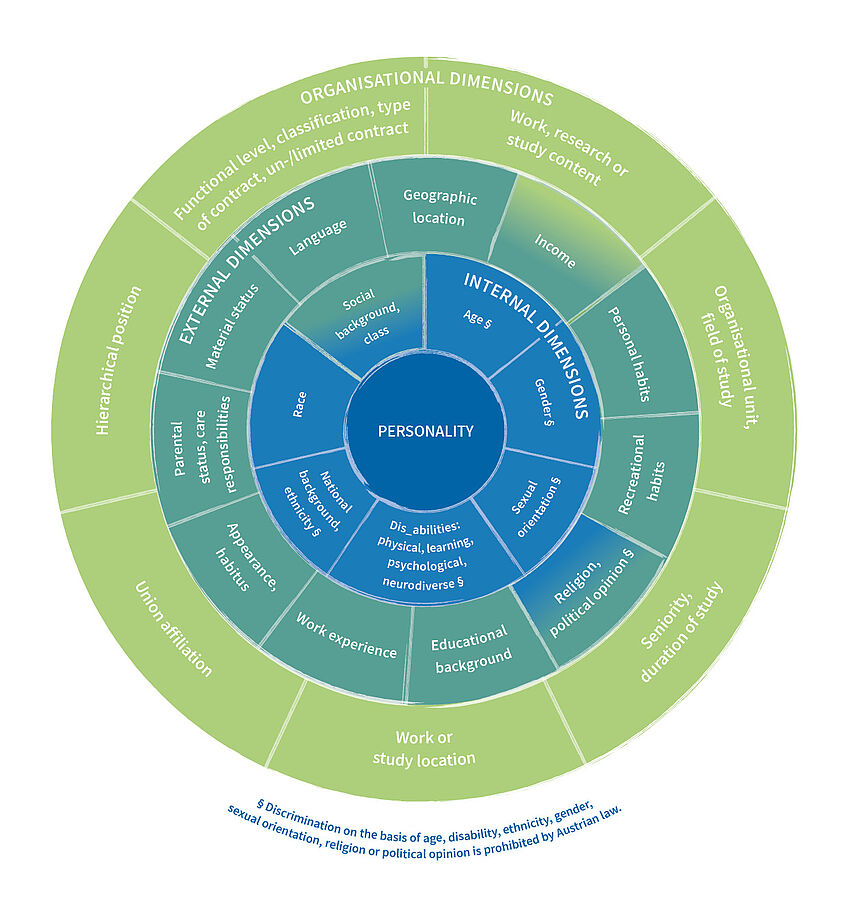Dimensions of diversity
The 4 Layers of Diversity model based on Gardenswartz and Rowe (2003) provides a widely used method of making visible dimensions of diversity in organisations. The model correlates roughly with the legally protected areas of discrimination. The mentioned dimensions of diversity are not to be read as an exhaustive list. The shapes that diversity and discrimination take can vary according to context and change with time.
At the level of organisational dimensions, the model was adapted to the university context. Additionally some dimensions central to the University of Vienna were added: in the external dimension that is “language”, and at the level of internal dimensions “social background/class”.

Source: 4 Layers of Diversity after Gardenswartz, L. and Rowe, A. (2003): Diverse Teams at Work. Society for Human Resource Management; courtesy of the authors. The adaptation of the organisational dimensions for the University of Vienna and addition to the dimensions was carried out by K. Iber and N. Pauser and updated by L. Appiano, N. Krebs and L. Vogelmann.
Graphic by Marion Wotruba (https://www.m-wotruba.at/)
PERSONALITY (innermost circle)
Personality, the dimension at the centre of the model, encompasses all aspects of a person that can be described as personal style.
INTERNAL DIMENSIONS (second circle)
The internal dimensions or core dimensions are understood to be relatively unalterable by the individual and are also acknowledged in the relevant equal opportunities legislation.
- age
- gender
- sexual orientation
- dis_abilities: physical, learning, psychological, neurodiverse
- national background, ethnicity
- race
- social background, class
Definitions
Neurodiversity is an umbrella term for different variations of neurological development (like autism, ADHD, dyslexia).
Social background/class does not belong to the so-called internal dimensions of diversity according to the model by Gardenswartz and Rowe (2003. However, it constitutes an important element of the understanding of diversity held by the University of Vienna. A person's social origin can be described - among other things - by means of economic or education-related features. For example, factors such as the level of education or the income of a person's parents can influence their access - or lack of access - to material and immaterial resources (e.g. their type of access to education, the extent of their financial means, etc.).
EXTERNAL DIMENSIONS (third circle)
The external dimensions are distinguished by their variability.
“Language” was not included in the external dimensions in the original model according to Gardenswartz and Rowe (2003). However, it constitutes an important element of the understanding of diversity held by the University of Vienna. Language can produce inclusion and exclusion in many ways, which is why it is important to use language sensitive to discrimination, among other things. One can differentiate between modes of communication (e.g. verbal or non-verbal), mono-/multilingualism (e.g. German, Turkish, Romanes, Austrian Sign Language), dialects (regional variations in speech) and sociolects (e.g. the language of academia, youth slang).
“Religion/political opinions” is an exception in this categorization. This category could be included in the internal dimensions for two reasons: religion and political opinions cannot always be freely chosen and it is also illegal to discriminate against anyone on the grounds of their religion.
“Income” is another exception in this categorization because it could also be included in the organisational dimensions: in the context of the university, income is shaped by dimensions like positions in the hierarchy, classification (e.g. in the collective bargaining agreement) or duration of employment.
ORGANISATIONAL DIMENSIONS (outermost circle)
The organisational dimensions are determined by the type of affiliation within an institution or organisation. The organisational dimensions of the 4 Layers of Diversity model based on Gardenswartz and Rowe (2003) have been adapted to the context of the University of Vienna.
